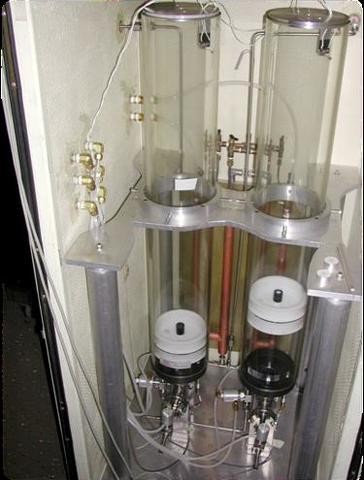NIST Gravimetric Hygrometer for Verification of NIST Humidity Standards and for Research on Humidity Properties

The NIST Thermodynamic Metrology Group has built a second generation gravimetric hygrometer, and a description of the hygrometer was published in Metrologia. A gravimetric hygrometer measures humidity by separating the water from the gas and subsequently determining the masses of the water and the gas separately. These masses are then used to calculate the water mole fraction in the gas, one of the principal humidity quantities. Other humidity quantities, such as the dew point and relative humidity, can be easily determined from the mole fraction using additional measurements of the pressure and temperature of the gas made before it enters the hygrometer.
The gravimetric hygrometer uses an automated continuous-flow gas collection system. The hygrometer uses a laser interferometry method in conjunction with a prover piston technique to increase the accuracy of the gas mass measurement. Currently, it is the only working gravimetric hygrometer in a national metrology institute. The hygrometer can measure mole fractions from 2.2 × 10−4 (a frost-point of −60 °C) to 0.31 (a dew point of 70 °C). Under optimal conditions, its relative uncertainty is within 0.09 % over most of its range.
The gravimetric hygrometer was constructed for the purpose of periodically verifying the performance of NIST standard humidity generators, which are used to calibrate customer hygrometers. These generators are based on thermodynamic principles, so knowledge of certain thermodynamic relations is essential for determining the humidity output. The Thermodynamic Metrology Group has performed comparisons between the gravimetric hygrometer and the NIST Hybrid Humidity Generator, and the results are also described in the Metrologia paper. These results show them to agree within the expanded combined uncertainties of the hygrometer and generator.
NIST's humidity standards are important to many types of end users. Hygrometers with calibrations traceable to NIST humidity standards are used by NOAA, the military, the pharmaceutical industry, semiconductor manufacturers, and the nuclear energy industry, to name a few examples.
While the gravimetric hygrometer was constructed for the support of NIST humidity standards, it is also useful as a research tool. For example, it has been used to help determine thermophysical properties of humid CO2 that are important for designing carbon capture and sequestration systems.
For more detailed information, see The second-generation NIST standard hygrometer.
Contacts
-
(301) 975-4825

